Recently I raised my concerns about an ‘art installation’ on display at a local event because I felt it was cultural appropriation. I raised my concerns with a Director on site and was completely rebuked in the most unsavoury way. Unable to leave the issue unaddressed I wrote an email to the CEO of the organization and I’m happy to say I received a response within a day and corrective action was taken within days. The apology I requested from the Director came by proxy from the CEO and it didn’t feel sincere or sufficient given the hostility the Director had put forwarded in the conversation.
The entire exchange between the Director and I took less than five minutes. However as I stood in the dust of his departure. I felt as if I had been physically assaulted. I don’t think there were a lot of people in the lobby at the time I felt as if I’d been punched in the stomach, knocked to the floor and humiliated in front of a crowd of thousands. For days after I felt belittled, dismissed and disrespected. It was a textbook experience of micro-aggression.
The concept of micro-aggression was developed by Harvard University Professor Chester M. Pierce in the 1970’s to describe verbal insults and put downs against black people. There are three types of micro-aggressions: micro-assaults, micro-insults and micro-invalidation. Micro-assaults are often overt (name calling, dismissive actions). Micro-insults are usually behaviours or comments that are insensitive to one’s heritage or culture. Micro-invalidation is the dismissal of the offended person’s feelings. Micro-aggressions can be done verbally, through non-verbal behaviour like avoiding eye contact or ignoring someone, or environmental – offensive pictures, props, segregated seating etc.
Early on in my career I heard a wonderfully simple approach to sorting our emotions. Basically an experience results in one of two feelings: yum and yuk. Pop culture has given me a third option – meh. This experience was definitely YUK. Five days after it happened my stomach was still upset over what happened. I decided to linger in this discomfort a little longer to deepen my understanding of why I was so impacted. I wanted to review it in detail, taking it apart bit by bit – shining a light on every dark corner. I needed to do an autopsy on this micro-aggression.
First, a little context. My cousin and I were at an outdoor summer event at the local botanical gardens where I am a member. On display on the grounds was a teepee draped in lace with throw cushions inside. About ten feet in front of the teepee was a large picture frame. Inevitably people began posing in the teepee behind the picture frame. This was not an indigenous event, there was no cultural context for the use of the teepee and blatantly the large picture frame in front of the teepee made the whole set-up a photo prop. As we made our way to the other side of the grounds there were three lace covered teepees set up – this time with no picture frame.
We asked a staff member what the ‘structures’ were for she said ‘oh relax – it’s just a tent – go take a picture’. Her exasperation made me feel as though this wasn’t’ the first time she had been asked this question. Sometimes silence becomes part of the problem rather than part of the solution. So I decided to speak to a manager to discuss my concerns.
Truth be told I was hoping that there was some contextual information missing that would clear this all up. Also on my mind was the fact that I held a membership to this organization which increased my sense of accountability. Yet my mind was racing. Would raising this issue would have any impact? I saw so many people posing for pictures under the display. Was this a ‘me’ thing? Why didn’t they see this as an issue? What if I missed something and made a wrong call?
The questions and concerns I had are a very common occurrence when one is challenging systemic inequities. In fact there are four major psychological dilemmas we experience when we are confronted with issues of inequity and the decision to intervene: “clash of racial realities, invisibility of unintentional bias, perceived minimal harm, and the catch – 22 of responding (Sue, Capodilupo, et al., 2007) You can find the Sue, Capodilupo et al article here. In the meantime, here’s my over simplified summary of these dilemmas.
- The clash of racial realities – when you may feel someone has exercised their racial privilege over you while the other party feels they’ve been fair and equitable
- The invisibility of unintentional bias – where one person either doesn’t see how their behaviours can be inequitable or states there was no intention of upset
- Perceived minimal harm – where someone dismisses their micro-aggressive behaviour as over sensitivity or over reaction of the other person – you know the whole – it’s no big deal, mountain out of a mole hill attitude
- The catch-22 of responding – where the the victim of the micro-aggression, questions their experience, has concerns about reporting and the repercussions.
There have been times when after running through these four scenarios I haven’t spoken up. Then on top of experiencing micro-aggressions I carry the guilt of not addressing them when they happen. Quite frankly, in a perfect world we shouldn’t have to deal with moments like these. When we do, I think it’s best if we are in a place of personal and emotional safety and that we trust our instincts. That day my convictions were so strong that they kept my legs moving in that direction while my head played catch up. I asked to see a manager who referred me to a Director and this is what happened.
Immediately after expressing my concerns to the Director he became very curt and quickly said “Thank you for your comments” and tried to walk away. I persisted saying that I really didn’t think that was a response. In a very dismissive tone he told me that comment cards were around the corner which is where I could put my comments and then again attempted to walk away. When I explained that I thought the display was particularly inappropriate given that the Pope had just left Canada after issuing an apology from the Catholic church for the residential schools the Director told me none of their displays were religious in nature and again attempted to walk away. When I told him that I had said nothing about religion he said “yes you did – you mentioned the Pope three times and none of our displays are religious in nature. As I said you’re welcome to fill out a comment card” And with that he walked away.
Years ago, when I experienced harassment, discrimination or micro-aggression, I didn’t have this understanding of what was going on. However after having a few of these micro-aggressive experiences, I was in no hurry to stand-up and either stand aside, behind or alone which in itself had it’s own negative consequences. Today we have the language to describe what’s happening and an increasingly aware and supportive social context. My autopsy report on this micro-aggression is below. I’ve decided that the something positive that can come out of this experience is the sharing this information with you in case you’re trying to make sense of an experience gone by or for future use.
Autopsy of Micro-Aggression
- Object belonging to a particular culture was used as a prop at the event
- The Director thanked me sarcastically for my ‘input’
- The Director told me to fill out a comment card
- When I persisted the Director told me my complaint was invalid
- The Director told me the object had nothing to do with religion
- The attempted to Director walk away from me several times
I know that progress seems slow or negligible in eliminating discriminatory behaviour. I didn’t have this information, language and understanding when I lived through discrimination in the past. Having it now not only helps me frame my experiences but validates their actual existence. I know that seems like a low bar for progress but at this point I’ll embrace anything that moves our world forward as I think the risk of going backwards has never been higher.Now that the autopsy is over, I’d like to share something personal with you that’s not in any article or book. It took over five days for my stomach to stop quivering from this experience. It was horrible. While on the scale of physical and emotional trauma, this experience is mild compared to others in my life but it did take something from me. I no longer have confidence in basic human courtesy.
I respect you too much to write a candy coated ending of how far we’ve come especially on a journey we should never have had to travel. This article is not just about racial inequity its about any inequity any of us endure in any element of our personhood. There is a lot of fear in our world today so people come out fighting even when they don’t need to fight. So remember safety first, stand up for what’s right when you feel you can, reach out for support when you need it and let’s bring the YUM back to our lives.
So how’s your day been? Let us know in a comment below #yum/yuk. #micro-aggression #antiracism #systemicdiscrimination #wrinklesintime #wrinklewisdom #wrinklewisdomtherapy

